Cellulose and Polylactic Acid: Biomimetic Multifunctional Packaging Film Rapidly Degrades in Soil Environment
Bionic structure design enables PLA degradation at room temperature. The study draws inspiration from the multilayer structure of natural leaves to construct a "leaf-mimicking bionic film LEAFF": using cellulose nanofibers (CNF) as the framework, polylactic acid (PLA) as the coating layer, and cross-linking the interface with isocyanate (HMDI), combining strength and degradability, and can completely degrade in room temperature soil within 5 weeks.
2. Multifunctional synergy enables high-performance packaging films. LEAFF exhibits excellent mechanical properties: tensile strength (118.1±8.6 MPa), elastic modulus (10.6±1.2 GPa), gas barrier performance (oxygen permeability as low as 0.772 cm³/m²·d·atm), high transparency (approximately 49% light transmittance), water stability (retaining 77% of tensile strength after 36 hours of immersion), as well as printability and other multiple properties.
3. Regulation by the microbiome reveals degradation mechanisms. Soil microbiome analysis showed that a unique micro-ecological environment is formed during LEAFF degradation, enriching special microbial species such as Planctoellipticum variicoloris. It is speculated that these microbes assist in the breakdown of PLA chains via a phagocytosis-like mechanism. Meanwhile, CNF serves as an energy supply carrier, synergistically promoting the kinetics of PLA degradation.
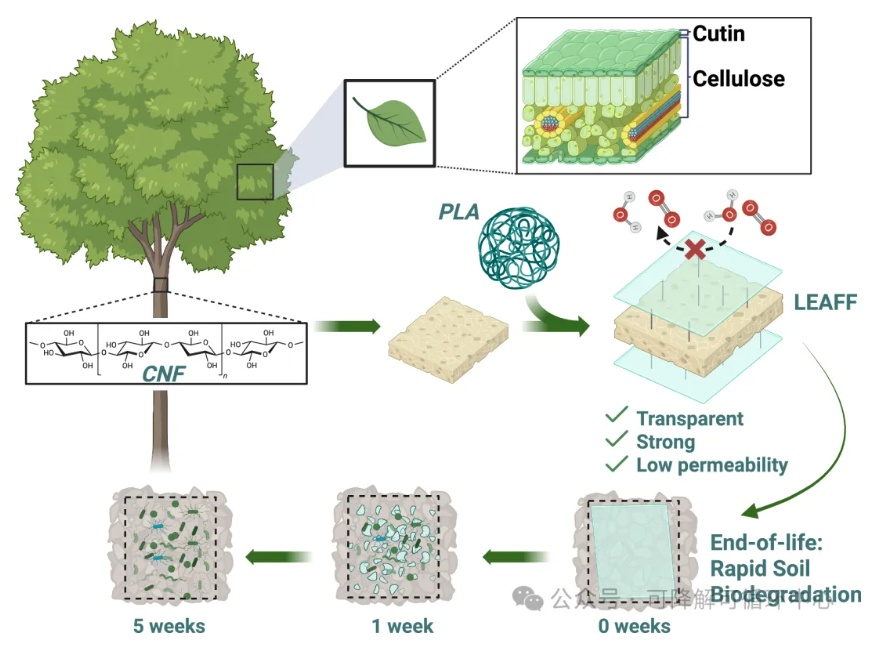
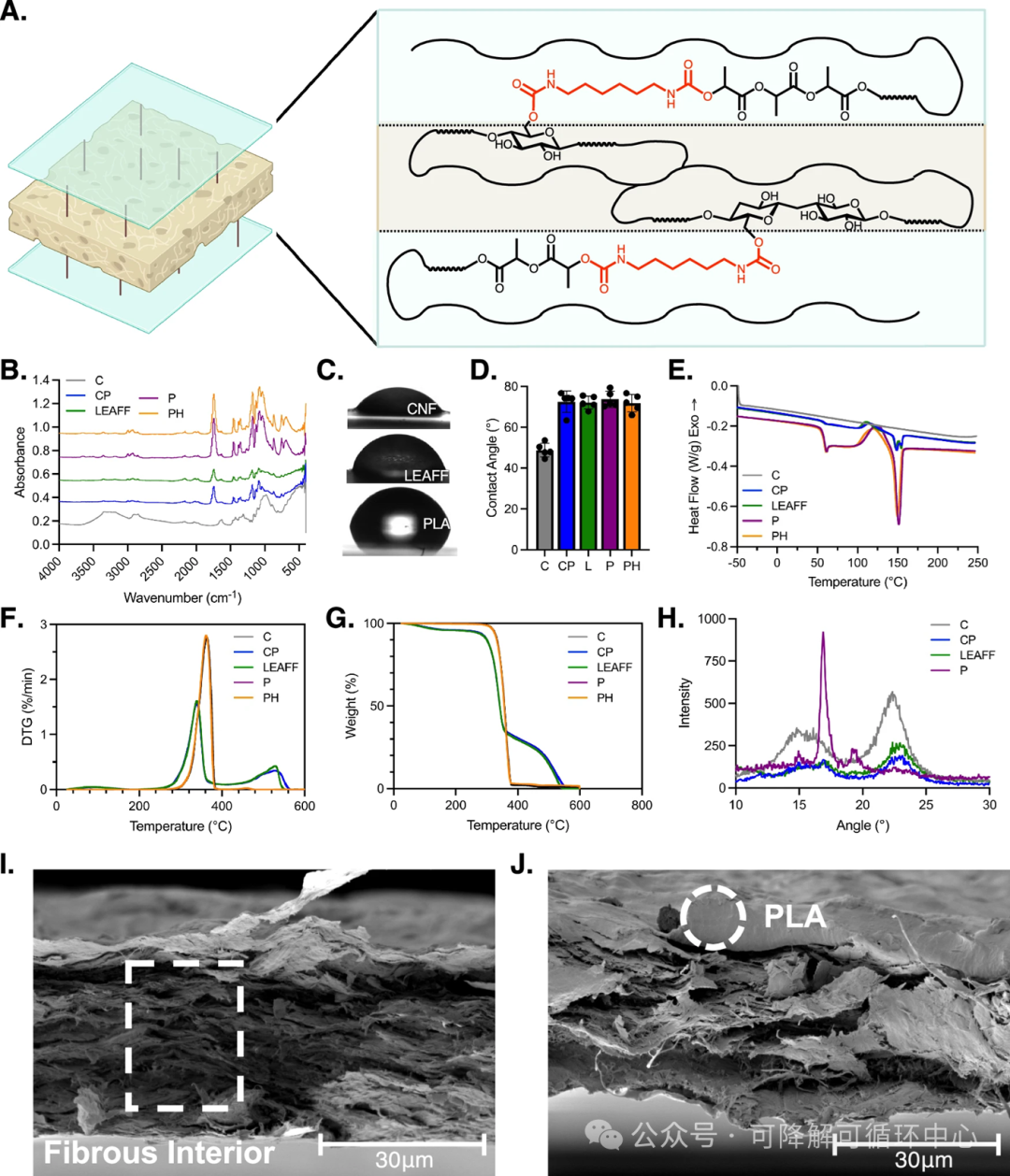
Figure 2. LEAFF microstructure and physical property characterization confirming PLA coating, interfacial crosslinking, and crystallization changes.
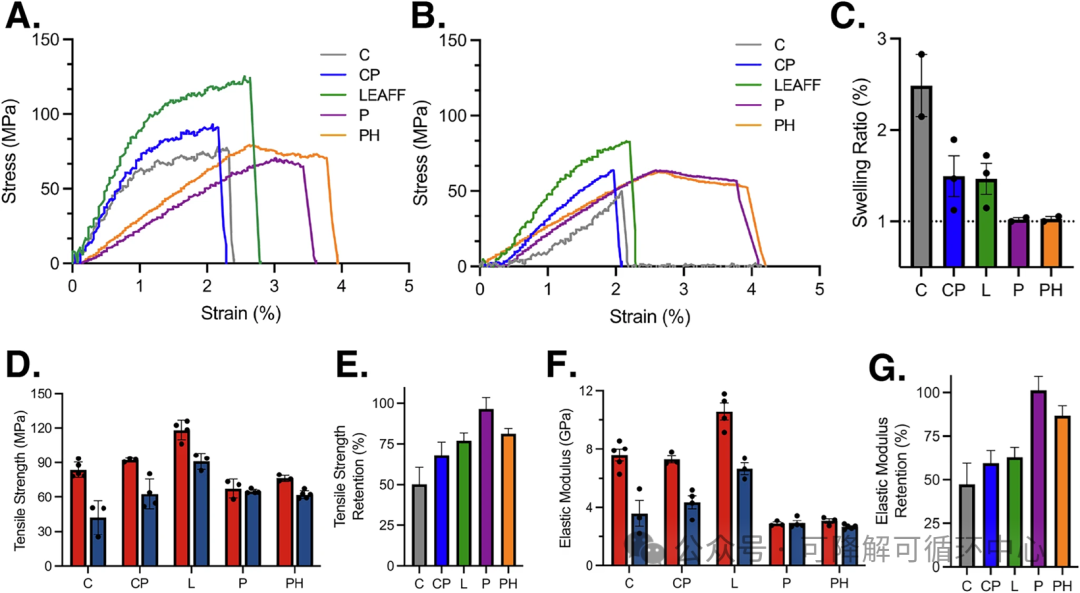
Figure 3. Mechanical performance tests of LEAFF in dry and wet states, demonstrating its superiority over traditional bioplastics and petrochemical film materials.
In the dry state, the tensile strength of LEAFF reaches 118.1 ± 8.6 MPa, and the elastic modulus reaches 10.6 ± 1.2 GPa, far exceeding pure CNF (83.7 ± 6.7 MPa, 7.6 ± 0.9 GPa), pure PLA (67.4 ± 8.3 MPa, 2.9 ± 0.2 GPa), and non-crosslinked CNF/PLA composite films (92.2 ± 1.6 MPa, 7.3 ± 0.4 GPa). After 36 hours of water immersion, LEAFF retains 77% of its tensile strength (91.1 ± 6.9 MPa) and 63% of its elastic modulus (6.7 ± 0.7 GPa), significantly higher than pure CNF (51%) and CNF/PLA (68%). Swelling tests show that the degree of swelling of LEAFF is close to that of pure PLA, indicating excellent water stability. This is closely related to its surface PLA coating, which is continuous and pore-free, effectively blocking water penetration.
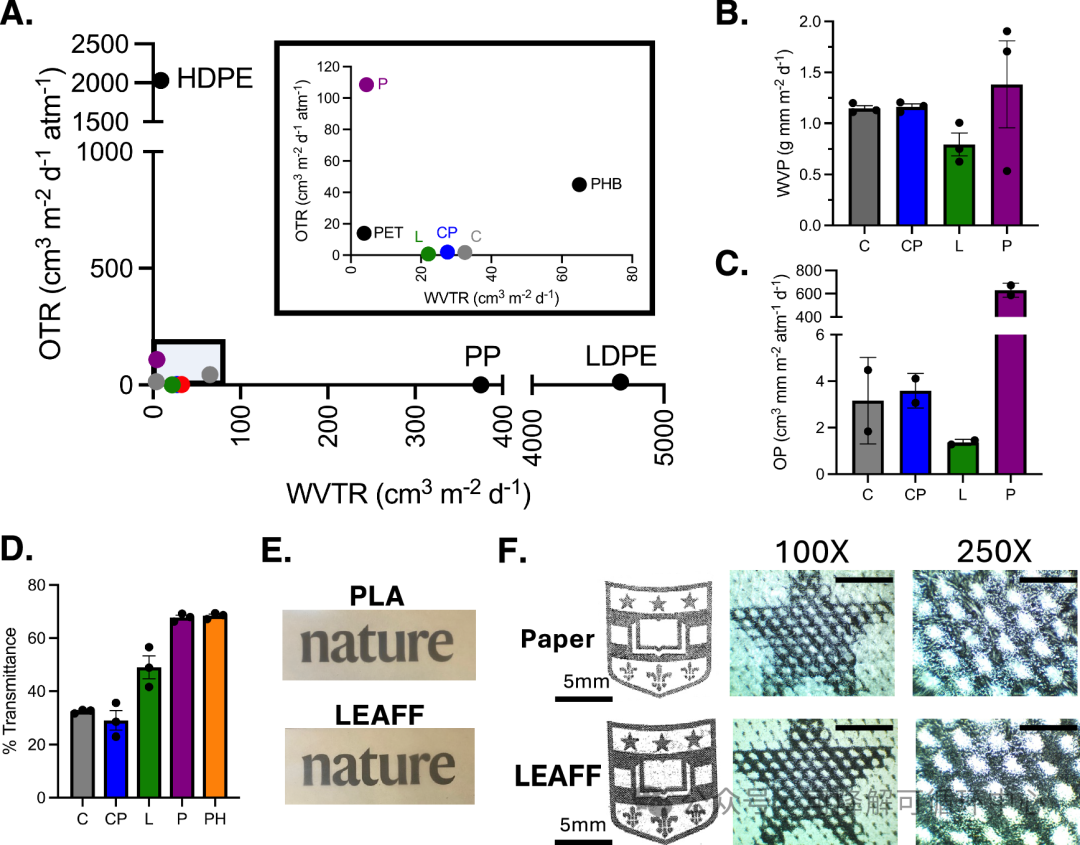 Figure 4. Multifunctional evaluation of LEAFF packaging, including oxygen/water vapor barrier properties, transparency, and printability.
Figure 4. Multifunctional evaluation of LEAFF packaging, including oxygen/water vapor barrier properties, transparency, and printability.
In terms of gas barrier properties, LEAFF exhibits a water vapor permeability (WVP) of 0.794 g·mm·m⁻²·d⁻¹, significantly lower than pure CNF (1.146), pure PLA (1.162), and non-crosslinked CNF/PLA (1.382); its oxygen transmission rate (OTR) is 0.772 cm³·m⁻²·day⁻¹·atm⁻¹, only 0.7% of pure PLA (108.5), demonstrating superior gas barrier performance compared to conventional plastics such as polyethylene and polypropylene. Regarding transparency, LEAFF has a light transmittance of approximately 49% at 600 nm, higher than CNF (33%) and CNF/PLA (29%), allowing clear visibility of text through it. Printability tests show that ink diffusion on its surface is less than that on traditional A4 paper, meeting packaging label requirements.
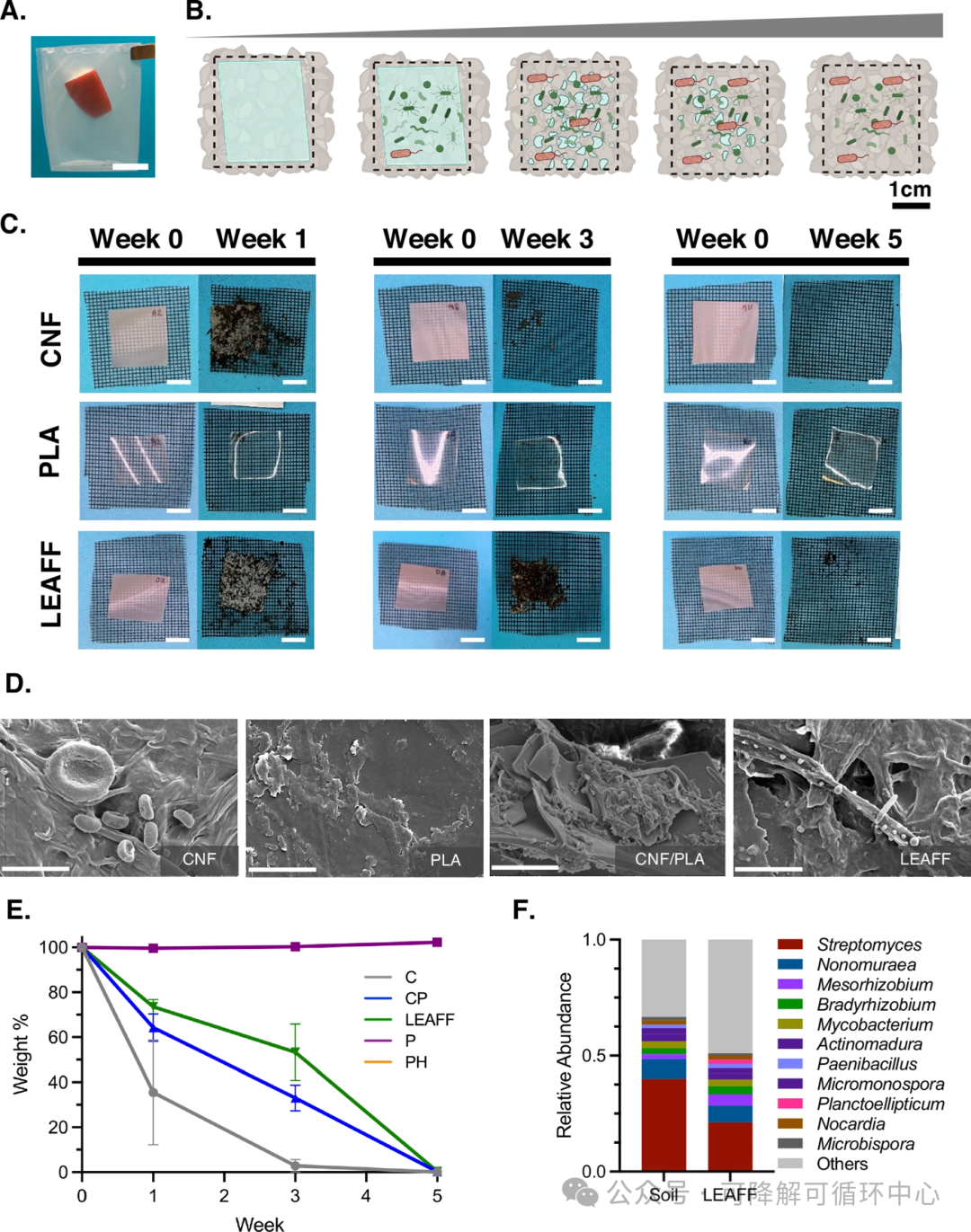
Figure 5. Degradation images of LEAFF in ambient temperature soil and analysis of microbiome changes reveal its rapid degradation mechanism.
Soil degradation experiments showed that LEAFF completely degraded within 5 weeks under conditions of 25°C and 40-60% humidity, while pure PLA exhibited no significant degradation. At 2 weeks, the remaining weight of LEAFF was about 40%, and SEM images revealed extensive microbial colonization on its surface, a phenomenon not observed on pure PLA. Microbial community analysis indicated that the Shannon diversity index in the LEAFF degradation environment increased from 6.5 (in soil) to 7.1, reflecting enhanced microbial diversity. Notably, the abundance of Planctoellipticum variicoloris—a Planctomycete bacterium capable of macromolecule uptake—rose significantly, suggesting that it may accelerate the degradation process by promoting PLA hydrolysis.
Our hypothesis is that the challenges of PLA biodegradation under environmental conditions are twofold: firstly, the chemical limitation of energy balance, and secondly, the physical limitation caused by the crystalline structure of PLA. The degradation of PLA involves an initial energy input for ester bond hydrolysis, followed by the release of low-energy lactide monomers that are converted into pyruvic acid and then funneled into central metabolism. Therefore, we hypothesize that the co-localization of high-energy cellulose provides energy for this energy-deficient microbial metabolic process, which is supported by the observation that soil microbial communities proliferate on LEAFF films but not on pure PLA films. Additionally, we engineered the films to enhance the contact between cells and secreted hydrolytic enzymes with the PLA polymer chains. Furthermore, the internal structure of CNF fibers allows soil microbes to grow and aggregate near the PLA material, further enhancing its biodegradability compared to pure PLA.
This work proposes a biomimetic hierarchical structure design to overcome the current bottleneck of “mutual exclusivity between high strength and biodegradability” in bioplastics. Inspired by the structure of plant leaves, CNF cores and PLA coatings are crosslinked via HMDI to achieve synergistic interfacial effects: on the one hand, the tensile strength and elastic modulus surpass those of conventional plastics (such as polyethylene and polypropylene); on the other hand, PLA is endowed with ambient soil biodegradability, addressing the limitation of PLA’s requirement for industrial composting. Meanwhile, by regulating the crystalline structure and densification, the material simultaneously achieves high transparency, water stability, and excellent gas barrier properties, integrating the multifunctionality required for packaging materials. In addition, it is discovered for the first time that specific microorganisms (such as Planctoellipticum variicoloris) can promote degradation, revealing a mechanism by which enhanced microbial diversity accelerates degradation. This provides a new structure–property–degradability correlation approach for bioplastic design.
【Copyright and Disclaimer】The above information is collected and organized by PlastMatch. The copyright belongs to the original author. This article is reprinted for the purpose of providing more information, and it does not imply that PlastMatch endorses the views expressed in the article or guarantees its accuracy. If there are any errors in the source attribution or if your legitimate rights have been infringed, please contact us, and we will promptly correct or remove the content. If other media, websites, or individuals use the aforementioned content, they must clearly indicate the original source and origin of the work and assume legal responsibility on their own.
Most Popular
-

List Released! Mexico Announces 50% Tariff On 1,371 China Product Categories
-

Nissan Cuts Production of New Leaf EV in Half Due to Battery Shortage
-

New Breakthrough in Domestic Adiponitrile! Observing the Rise of China's Nylon Industry Chain from Tianchen Qixiang's Production
-

Dow, Wanhua, Huntsman Intensively Raise Prices! Who Controls the Global MDI Prices?
-

Mexico officially imposes tariffs on 1,400 chinese products, with rates up to 50%






